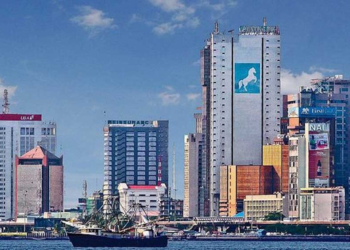Despite recent statements from the Central Bank of Nigeria (CBN) Governor, Olayemi Cardoso, concerning the country’s external reserves, data from the CBN has revealed a concerning trend, with reserves reaching a new low of $32.1 billion as of April 18, 2024.
This downward trend marks a significant decrease from previous levels, with reserves standing at $32.29 billion on April 15, $32.20 billion on April 16, and $32.12 billion on April 17 before hitting the new low.
Analysis of CBN data indicates that the last time reserves reached such levels was on September 29, 2017, when it stood at $32.49 billion.
Speaking at the just-concluded IMF/World Bank spring meetings in Washington DC, United States, Cardoso addressed concerns over the drop in reserves, attributing it to typical fluctuations related to debt obligations and incoming funds.
He highlighted recent inflows of about $600 million into the reserves account and emphasized that the CBN’s focus remains on maintaining an independent market driven by willing buyers and sellers.
Cardoso stated, “The shifts you’ve seen in our reserves have really little or nothing to do with defending any naira, and that is certainly not our objective.”
Despite the fluctuations, he reassured that there’s no need for undue excitement, reiterating the CBN’s commitment to fostering a market operating independently and facilitating price discovery.
The trajectory of Nigeria’s reserves has been volatile, with fluctuations observed over the past several months. In February 2024, reserves reached a four-month high of $33.45 billion before reversing course.
A one-month analysis revealed a steady decline from $32.61 billion on April 12 to the recent low of $32.1 billion on April 18.
Despite ongoing fluctuations, the CBN has implemented strategies to support the naira, including discounted sales to Bureau de Change operators and interventions in the official window. Talks with the World Bank for concessionary loans, as well as other multilateral loans, are expected to bolster reserves in the near term.
Despite recent statements from the Central Bank of Nigeria (CBN) Governor, Olayemi Cardoso, concerning the country’s external reserves, data from the CBN has revealed a concerning trend, with reserves reaching a new low of $32.1 billion as of April 18, 2024.
This downward trend marks a significant decrease from previous levels, with reserves standing at $32.29 billion on April 15, $32.20 billion on April 16, and $32.12 billion on April 17 before hitting the new low.
Analysis of CBN data indicates that the last time reserves reached such levels was on September 29, 2017, when it stood at $32.49 billion.
Speaking at the just-concluded IMF/World Bank spring meetings in Washington DC, United States, Cardoso addressed concerns over the drop in reserves, attributing it to typical fluctuations related to debt obligations and incoming funds.
He highlighted recent inflows of about $600 million into the reserves account and emphasized that the CBN’s focus remains on maintaining an independent market driven by willing buyers and sellers.
Cardoso stated, “The shifts you’ve seen in our reserves have really little or nothing to do with defending any naira, and that is certainly not our objective.”
Despite the fluctuations, he reassured that there’s no need for undue excitement, reiterating the CBN’s commitment to fostering a market operating independently and facilitating price discovery.
The trajectory of Nigeria’s reserves has been volatile, with fluctuations observed over the past several months. In February 2024, reserves reached a four-month high of $33.45 billion before reversing course.
A one-month analysis revealed a steady decline from $32.61 billion on April 12 to the recent low of $32.1 billion on April 18.
Despite ongoing fluctuations, the CBN has implemented strategies to support the naira, including discounted sales to Bureau de Change operators and interventions in the official window. Talks with the World Bank for concessionary loans, as well as other multilateral loans, are expected to bolster reserves in the near term.










